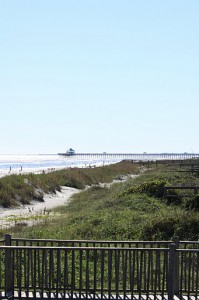 Winter is officially gone, and spring already feels more like summer here. Memorial Day is fast approaching, and the ocean should be warm enough for a swim soon. We wanted to conclude our beach safety series with a discussion of potentially dangerous ocean water conditions and sea animals. After all, if you know what to look for, you are better able to protect yourself.
Winter is officially gone, and spring already feels more like summer here. Memorial Day is fast approaching, and the ocean should be warm enough for a swim soon. We wanted to conclude our beach safety series with a discussion of potentially dangerous ocean water conditions and sea animals. After all, if you know what to look for, you are better able to protect yourself.
Flags
Folly Beach and other lifeguarded Charleston-area beaches have a flag system to warn visitors of dangerous conditions. Designated lifeguarded swimming areas will always be marked with two red-over-yellow flags. A solid yellow flag means you should be especially cautious because the water is rougher than normal or because of the presence of potentially dangerous sea life. A red flag denotes no swimming. If you see a red flag, you should not go into the water; it has been closed because of dangerous currents, lightning or a serious storm threat. A purple flag means that sea pests are present in higher than average numbers; it does not mean that sharks are present, and you can still swim with caution.
Water Conditions
It’s important to be mindful of ocean currents when enjoying the warm water of Charleston area beaches. Even if the water seems calm, currents can be powerful and they can easily move swimmers away from where they entered the water. It’s a good idea to swim with a friend and to always keep an eye on the shoreline to make sure you’re not drifting too far away. Rip currents are especially dangerous because they are fast-moving currents that move away from the shoreline. Rip currents at Folly and other Charleston area beaches can move up to eight miles an hour. Learn to recognize a rip current. If the water looks especially choppy or is a different color, a rip current could be present. Also, rip currents will suck seaweed and debris out to sea. If you become caught in a rip current, don’t panic; the current will not pull you under. To get out of the rip current, swim parallel to the shore or diagonally toward the shore, but don’t try to fight the rip.
When swimming in the ocean, remember that although the shore usually has an even, gradual slope, there will be some sudden drop-offs and other irregularities. At low tide, sandbars are often visible off the shores of Charleston beaches, but swimming out to these inviting-looking sandbars is not advisable. When the tide comes in, you could easily become stranded far from shore and subjected to strong currents. Finally, if you are in the water but not enjoying it because the waves are too rough or you keep getting pulled under, don’t fight to stay in. Go ahead and take a rest, enjoy the sand and sun or take a stroll. The water will calm down, and there will be other opportunities for you to enjoy it.
Sea Life
Charleston area beaches are beautiful and inviting, but we do have to share the water and sand with some not-so-pleasant sea creatures. Stingrays and jellyfish both present a real threat to beachgoers during the summer months with August often being the peak. Jellyfish are present in the water, and they often wash up on shore; if you see numerous jellyfish on the shore, that’s an indicator that they are also present in the water. Be careful not to step on jellies that have washed up on the sand, as they can still inflict a sting. You can often swim in the water when jellyfish are present, but there is no real way to avoid contact with them — it’s just a matter of taking your chances. If an abundance of the creatures is noticed, lifeguards will alert beachgoers with purple flags. If you do get stung by a jellyfish, compressing the injury with a vinegar-soaked cloth often helps soothe the pain. Some stings are more severe than others, and large stings warrant medical attention. Also, some folks are allergic to jellyfish stings, and if nausea, lightheadedness or faintness occurs after a sting, medical attention is necessary.
Stingrays also populate our waters. You can avoid being stung by a stingray by shuffling your feet along the ocean bottom rather than lifting up a foot and then putting it back down. When you keep your feet in contact with the ocean bottom, you are more likely to nudge a stingray ands scare it away, but if you lift up a foot and then put it back down, you could potentially step directly on the animal, make it feel trapped and cause it sting.
Sharks pose minimal threat at Charleston area beaches. While we do have almost 40 different shark species living in our coastal waters, most are quite docile. Also, the Continental Shelf where large sharks feed is situated almost 50 miles off our shoreline, so sharks rarely come close enough to the shore to affect vacationers.
Conclusion
So there you have it: Charleston-area beaches — like all beaches — have a few potential hazards, but mishaps are often avoidable. If you haven’t already taken a look at our other two beach safety guides, here are their links:
Now that you know what to look for, get your gear and come on down to Charleston’s beaches. We can’t wait to see ya’ll here! If you have any questions about Charleston-area beach real estate, please feel free to give Bob Brennaman a call at 843-345-6074.
Recent News